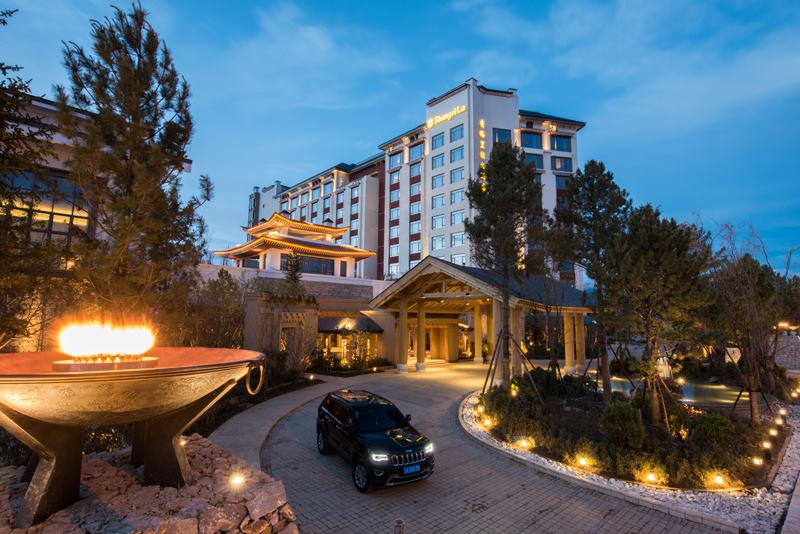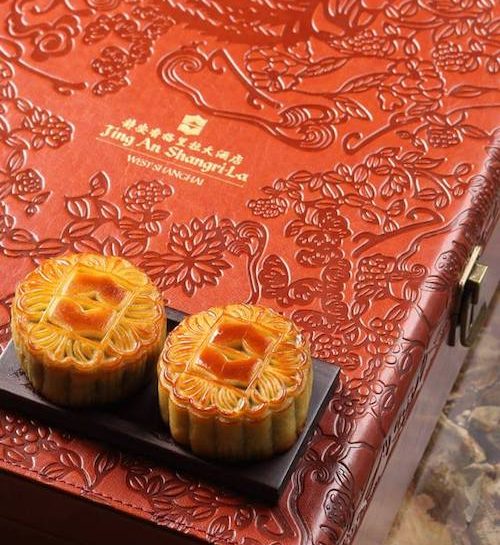
Destination Shanghai
Contributed by feature reporter Jens Hoffmann
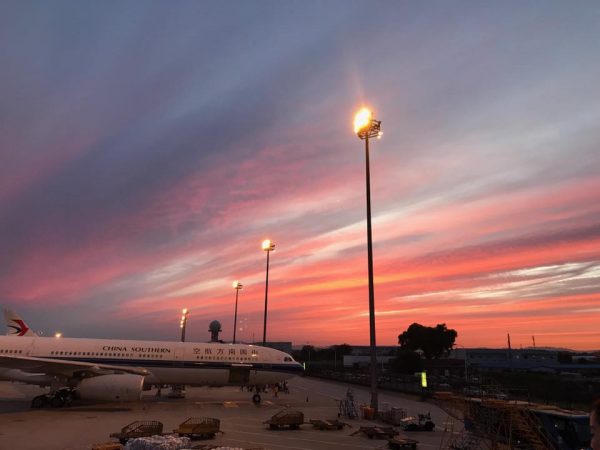
After a happy landing in Hong Qiao International Airport (SHA) I enjoyed the drive with the airport express train (455 km/h, wow!!!) to Pudong.
10 minutes later I arrived.
Yes, I am a fan and love it to be in Shanghai.
Pudong or Puxi boy
Shanghai is unique in its cultural division between Pudong and Puxi, the city’s two main neighborhoods.
These opposing parts of town—named after their location in relation to the Huangpu River, with “dong” meaning east and Xi meaning west—are different culturally as well as geographically.
Pronounced “poo shee,” Puxi is the historical heart of the city.
In former foreign concession times, this was the area that hosted the multitude of foreign nationals from the mid-19th century to the World War II. The area had a French Concession and an International Concession as well as a walled Chinese area.
It is in this area that the historical houses and buildings the Bund, and the famous Art Deco heritage architecture are found.
The landscape here is almost infinite.
Stretching from the eastern banks of the Huangpu River, Puxi blossoms outward in all directions.
If you’re driving from Shanghai to Jiangsu Province or Hangzhou (in Zhejiang Province), you may even feel like you never left the city.
As you move west along the Yan’an Elevated Highway, you’ll pass by the clusters of skyscrapers around People’s Square, along Nanjing Road, and then further out toward Hong Qiao.
Puxi is a never-ending mass of office towers and residential places.
It’s also where the Hong Qiao International Airport (SHA) is located as well as the two train stations and the long-distance bus terminals.
Just a few decades ago, Pudong was home to a slew of warehouses as well as farming and fishing communities.
Now, it is home to some of the tallest buildings in China, such as the Shanghai Tower and the Shanghai World Financial Center.
Whereas Puxi is somewhat of a blast of Shanghai’s past, Pudong is a glimpse into its future.
The distinction between the two cities is almost alarming as you look out across the Huangpu River at the opposing skyline.
Pudong’s landscape differs from Puxi’s in that it’s more compact.
The river actually cuts it into a virtual island so that if you keep driving, you’ll eventually end up at the sea.
There aren’t any beaches, Pudong’s tall buildings are clustered around the financial center in Lujiazui and it’s here that you’ll find many of Shanghai’s most luxurious residences and hotels.
Further out, you can still find some small farm operations that haven’t been bulldozed into residential compounds.
Pudong is home to Shanghai’s biggest and main airport, the Pudong International Airport (PVG). It is connected to the rest of the city via a number of tunnels, bridges, metro lines, and ferries.
You’ll want to concentrate your trip on this side of the river if you’re interested in having a big city vacation while in Shanghai.
Place to stay: Shangri-La
My hotel, the Shangri-La Jing An is located on the Puxi side of the Huangpu River.
It features a design inspired by Shanghai’s past, present, and future.
The 508-room hotel is the centerpiece of the Jing An Kerry Centre.
Upon entering the lobby, guests are greeted by a 19 x 10-foot oil painting by Zeng Fanzhione of two renowned contemporary artists who were commissioned to create pieces for the hotel.
The other is Zhou Chunya, whose series of five paintings for Jing An are inspired by Shanghai’s Yu Garden. The hotel art collection includes around 200 pieces by 50 artists, representing 12 countries.
Fourteen of the 50 artists represented in the collection are Chinese. It includes sculptures, paintings, works on paper, photography, textile art, and decorative objects. Each work pays homage to Chinese culture. Hand-tufted silk carpets found throughout the hotel were designed to resemble paintings and take inspiration from traditional chinese watercolors, lotus, auspicious fish, and colorful blooms.
The hotel is very Shanghainese, it is a balance of the new and the traditional.
Shangri-La hotels use Shangri-La as a fictional place described in the 1933 novel “Lost Horizon” by James Hilton.
He describes Shangri-La as a mystical, harmonious valley, enclosed in the western end of the Kunlun Mountains. Hugh Conway, a veteran member of the British diplomatic service, finds inner peace, love and a sense of purpose in Shangri-La, whose inhabitants enjoy unheard-of longevity.
Thats why Shangri-La has become synonymous with any earthly paradise, and particularly a mythical Himalayan utopia — a permanently happy land. The hotel’s four bars and restaurants reflect Shanghai’s eclectic and cosmopolitan nature. Summer Palace’s contemporary design takes inspiration from Chinese traditions with golden yellow, orange, green, and blue furnishings, and artwork and accessories inspired by the peacock. In the 1515 West, Chophouse & Bar, premium beef and American-sized desserts are served in a classic New York steakhouse interior. The Artifacts from Shanghai’s historic movie productions gives the place glamor. We saw already a few celebrities and enjoyed the crystals, more than four million crystals. The bling-bling crystals are used as architectural elements, from the thick canopy of lighted rods covering the porte-cochere to the drapery anchoring the double-height reception area and lobby lounge.
Shangri-La hotels are alwyays fun and do not forget to read the book – the story behind “Shangri-La” as a night cap.

Restaurant tips in Shanghai:
Three on the Bund
Its in one of the glorious 1920s colonial buildings, converted into an art gallery and designer shopping emporium, with four restaurants. The 7th floor roof terrace has a fabulous view over the river and Pudong. The restaurants are Laris, New Heights, the Whampoa Club, and Jean Georges (outpost of the New York chef Jean Georges Vongvichteren). On the top of the building is a little cupola, which has been cleverly converted into two private dining rooms, each with just one table. The upper cupula has a table for two, the lower one a table for up to eight. In these you can eat a menu prepared by any of the restaurants, or indeed even mix and match courses if you wish. We had lovely Sea Scallops and Lobster Tartine, Lemongrass, Fenugreek Broth, Pea Shoot. It was fantastic.
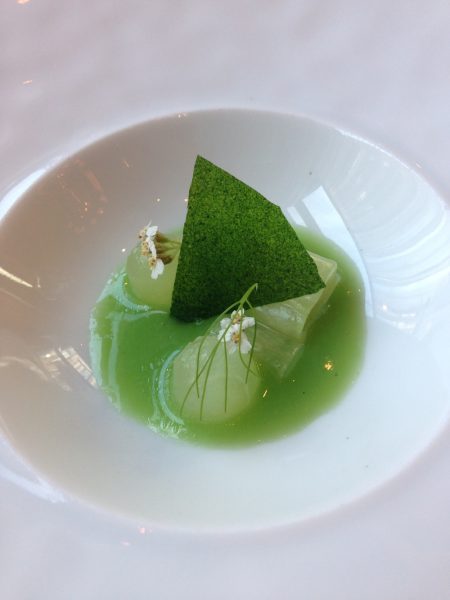
The chef Jean Georges is known for its use of spices with more classical dishes, and indeed this was on show tonight e.g. the lobster had very distinct spices. The Desserts were an excellent mix of chocolate dishes, including a fine chocolate fondant.
Overall a yummy lovely exerience on the bund, the great thing here is the setting. YYou have the sense from this that it is a bit of an unusual novelty rather than a pure dining destination, but it is a seriously romantic setting.
Tip #2: Absolutely fun. Restaurant “Ultraviolet”
OK you need a budget, the dinner will be around 400€ with wines.
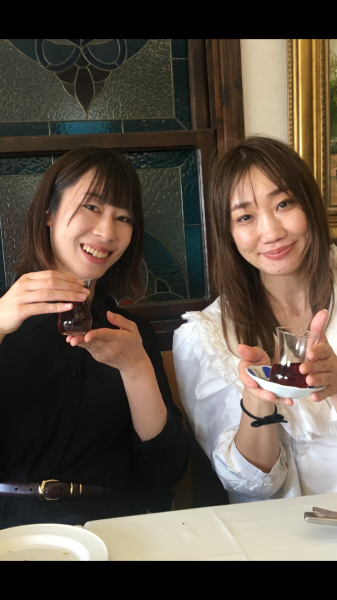
A revolutionary 10-seat multi-sensory experience restaurant Ultraviolet. It will evoke a ‘bold and exclusive dining experience that engages all the senses to create the ultimate luxury.
Ultraviolet, a sort of dress rehearsal for the final draft of the restaurant which has finally rolled out. And after this, admittedly invited, tasting, we can say definitively that yes, Ultraviolet is radical and it was very much worth the wait.
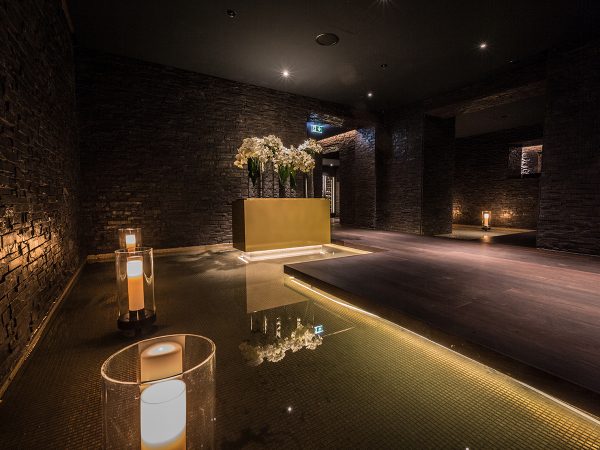
Ultraviolet is located in a secret location in an old Shanghai neighbourhood. After being driven to the restaurant by their private driver, you enter a set of inconspicuous double doors and cross into Pairet’s fantasy restaurant: a mixture of James Bond lair and mad scientist laboratory. Mesh metal doors slide open without any visible human attendants. Your chilled drink awaits on a bar counter of raw wood. After a few sips, another door slides open, beckoning you down a hallway lit by a Baccarat crystal chandelier. Then, a final set of doors slides open. You can’t help but laugh as the 2001: A Space Odyssey opening chords play while you step into the all-white dining room: a plain rectangular table flanked by 10 white adjustable chairs. The dining experience begins.
Each course is paired with 360 degree video projections, surround sound music (a different song tailored to each course) and even custom scents: sometimes they waft from a pressure cooker which is hand carried around the room, sometimes from a scent machine installed in the ceiling and with one course, the scent of cigar smoke captured in a glass dome is held up to your nose by a waiter. The full dinner includes 20 ‘avant garde’ courses, for other courses, many of which are paired with drinks ranging from dessert wine to peppermint tea, projections include crashing ocean waves, ancient trees in fog or Indonesian masks. A ‘micro fish and ship’ course is actually a single giant caper berry deep fried in batter and paired with anchovy tartar sauce. The food is central to the night, never just a prop; each meticulously crafted bite amazing and a lovely finsish.
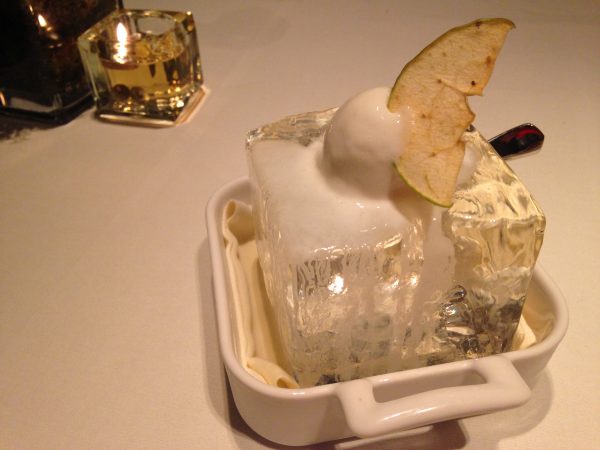
Yummy.
